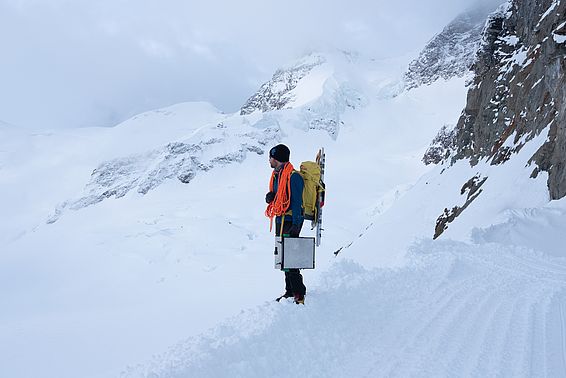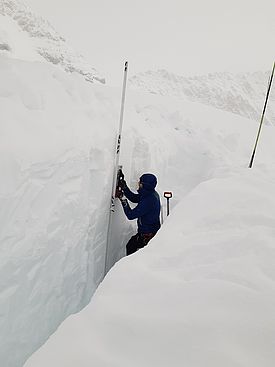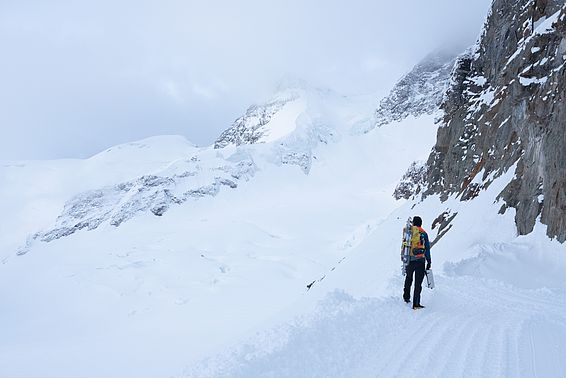07.03.2024 | Jochen Bettzieche | SLF News
SLF physicist Lars Mewes is investigating snow crystals' direction of growth and analysing snow profiles at the Aletsch Glacier. His work is part of a collaboration with other institutions, which the SLF was invited to join because of its expertise on snow.
Thin air, peak temperatures of around -10 °C – SLF snow physicist Lars Mewes has swapped his cosy office in Davos for a workplace of extremes this week. Since Monday, he has been at the high-altitude research station on the Jungfraujoch, at an elevation of over 3,400 metres. From there, he sets off daily on skis to the Jungfraufirn, 200 metres below, to take measurements and snow samples for the cold laboratory in Davos. "As a snow expert, I'm supporting a project run by the German Aerospace Center (DLR) and ETH Zurich," explains the scientist. The research institutions called in the SLF specifically because of its expertise in this area.
Measuring structures
The ETH Zurich researchers have installed a ground-based radar on the Jungfraujoch, which they are using to measure the amounts of new snow as well as the structure of firn and of the entire glacier. Mewes digs snow profiles directly on the glacier and then analyses them. "Thanks to our SnowImager, a device for determining snowpack structure, we're able to achieve a very fine resolution, in the millimetre range," says the physicist. The ETH Zurich researchers then compare his findings with the results of their radar images. This enables them to identify how well their method is already working – and where they may need to make improvements.
Mewes' work is not without its risks. While on the glacier, the researchers secure each other by a rope in case a crevasse opens up. And the thin air makes itself felt on the return journey to the station, which involves climbing several hundred metres in altitude on touring skis, while carrying a lot of baggage. He will return to Davos at the end of the week.
Closer to reality
In late March, the DLR aircraft will circle over the Jungfraujoch and the Aletsch Glacier, weather permitting. SLF researchers will then return to the site, among other things to investigate the anisotropy of snow crystals (see box) in new snow. "We're taking a reference measurement here to determine the direction in which the ice crystals are orientated," explains Mewes. This will then be used by the DLR researchers, as they will be measuring the snowpack from the plane using radar. So far, they have only compared theoretical values from the scientific literature with their data. The SLF's work should help yield results that are closer to reality.
What is… anisotropy?
Properties and processes that have a direction but differ according to the direction of measurement are called anisotropic. The growth and formation of crystals is an anisotropic process, as is the propagation of a laser beam. The opposite are isotropic processes, such as light rays from the sun, which, unlike laser beams, spread out evenly in all directions.
Contact
Copyright
WSL and SLF provide image and sound material free of charge for use in press releases in connection with this media release. The use of this material in image, sound and/or video databases and the sale of the material by third parties is not permitted.


